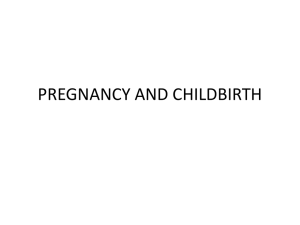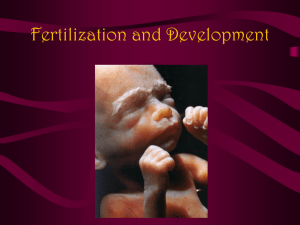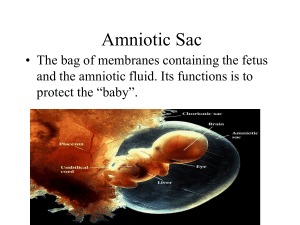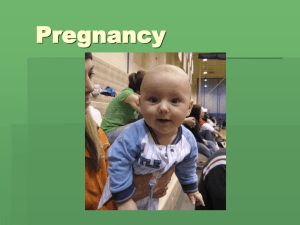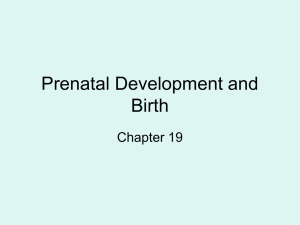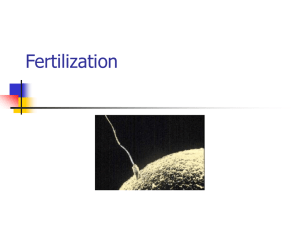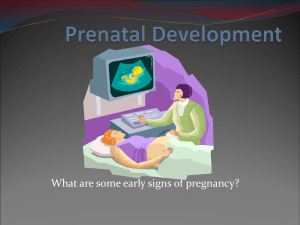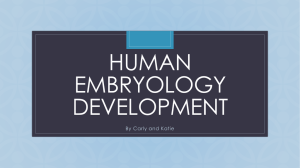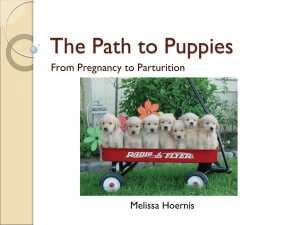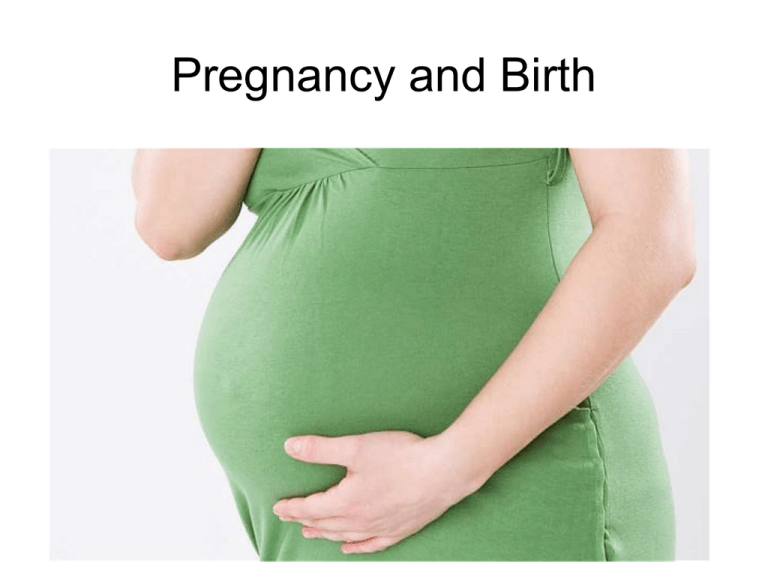
Pregnancy and Birth
THE BEGINNING OF THE LIFE CYCLE
Fertilization / Conception
• When the males sperm enters the females egg
• 1 sperm / 1 egg
• Within seconds of fertilization, the surface of
the egg changes so that no more sperm may
enter the egg
Zygote
• The united egg and sperm
• Within 36 hours, while the zygote is in the
fallopian tube, it begins to divide
Cell Division
•
•
•
•
•
The original cell divides to make 2 cells
24
48
8 16, etc.
From the 2 cell stage until about 9 weeks after
fertilization, the growing structure is called an
embryo
The Blastocyst
• 5 days after fertilization, the embryo reaches
the uterus
• Floats free
• 50 to 100 cells
• Blastocyst – sphere of
cells surrounding a
hollow center
Implantation
• Once the blastocyst forms, it implants itself in
the uterus implantation
DEVELOPMENT IN THE UTERUS
Amniotic Sac
• After implantation, a fluid-filled bag of thin
tissue called the amniotic sac develops around
the embryo
• It grows as the
embryo grows
• Embryo floats in
amniotic fluid
Placenta
• The attachment that holds the embryo to the
wall of the uterus
• Here, oxygen and nutrients move from the
mothers blood into the embryo
• Dangerous substances can pass from mother
to embryo, too
– Alcohol, drugs, chemicals
Umbilical Cord
•
•
•
•
•
25 days
Ropelike structure
Connects embryo to placenta
The embryo’s lifeline
Carry nutrients and oxygen from the placenta
to the embryo
• Carry wastes from the embryo to the placenta
The Growing Embryo
• During the first 2 months:
– Major body systems and organs form
• Heart, Blood vessels, Kidneys, Endocrine glands
• At the end of 2 months:
– Embryo is an inch long
– Recognizable external features
• Eyes, ears, arms, legs
– Head makes up 50% of embryo
The Fetus
• From the 3rd month until birth, the developing
human is called a fetus
• 3rd to 6th months – begins to kick
– Skeleton and muscles are developing
• Nervous system matures
– Sense organs begin functioning
• Fetus becomes sensitive to light and sound
• Alternates periods of activity with sleep
The Fetus
• 7th to 9th months
– Body size increases; more proportionate
– Body fat accumulates
– Eyelids open and close
• End of 9th month
– Fetus is ready to be born
Worksheet Word Bank
Fertilization
• Blastocyst
• Fertilization
• Early Cell Division
• Blastocyst & Implantation
• Late Cell Division
Embryo
• Cervix
• Vagina
• Amniotic Sac
• Developing Placenta
• Amniotic Fluid
• Uterine Wall
• Umbilical Cord
A HEALTHY PREGNANCY
Staying Healthy During Pregnancy
• Proper nutrition
– “eating for two”
• Exercise
– Better meet the energy needs of carrying a baby
• Avoiding alcohol and other drugs
– Harm, kill, decrease chance to live, lifelong problems
• Avoiding environmental hazards
– X-rays, lead, mercury (fish), cat litter (parasites)
Prenatal Care
• Medical care during pregnancy
• Obstetrician – doctor specialized in pregnancy
and childbirth
• The chances of having a healthy baby greatly
increases with regular doctor checkups
throughout pregnancy
3 Trimesters
• Pregnancy is divided into 3 periods of time
• Each is about 3 months long
• 1st trimester 0-3 months
• 2nd trimester 3-6 months
• 3rd trimester 6-9 months
Monitoring Tools
• Ultrasound
– High-frequency sound waves that produce an
image of the fetus
• Chorionic Villus Sampling (CVS)
– At 8 weeks, dr. removes part of the placenta to
check for abnormalities/disease
• Amniocentesis
– 14-16 weeks, inserting a needle in the abdomen
and uterus to remove amniotic fluid to test for
abnormalities
Complications
• Ectopic pregnancy
– Blastocyst implants in the fallopian tube, not the
uterus
• Miscarriage
– Death of embryo or fetus in first 20 weeks
• Preeclampsia
– High BP, swelling of wrists & ankles, high levels of
protein in urine prevents fetus from getting O2
• Gestational diabetes
– Developing diabetes while pregnant
CHILDBIRTH
The Birth Process
1. Labor
2. Delivery of the baby
3. Delivery of the afterbirth
Labor
• Work performed by the mother’s body to
push the fetus out
• 2 to 24 hours or longer
• Uterus contracts, causing the cervix to
increase in width, or dilate
• Amniotic sac will break
• Cervix becomes softer and wider too allow the
fetus to pass through
Delivery of Baby
•
•
•
•
Actual birth, or delivery of baby
Lasts 30 minutes to more than 2 hours
Baby usually exits head first through vagina
Once the baby is out:
– Dr. clamps and cuts the umbilical cord
– Baby’s nose & mouth are suctioned to remove
mucus and make it easier to breath
– Eye drops are given to prevent infection
– Injection of vitamin K to prevent excess bleeding
from umbilical cord
Delivery of Afterbirth
• Though the baby is born, the birth process is
not complete
• Uterus contractions push out the placenta
• 15 to 30 minutes
Complications at Birth
•
•
•
•
Surgical delivery
Premature birth
Low birth weight
Birth of more than one baby
Surgical Delivery
• Sometimes delivery through the cervix and
vagina is not possible due to the position of
the fetus or the narrowness of the mothers
hips
• Illness or other conditions that make vaginal
delivery dangerous for mother and/or baby
Cesarean Section
• Surgical method of birth
• Doctor makes an incision in the lower
abdomen into the uterus
• Then removes the fetus and placenta
Premature Birth
•
•
•
•
•
Baby is born before it is fully developed
Before the 37th week of pregnancy
Earlier birth more problems
Lungs are usually not developed
Receive care in an incubator
Low Birth Weight
• Less than 5.5 pounds
• May also be premature
• May be full-term, just didn’t grow enough
before birth
• Increased risk of health problems as a
newborn, chronic lifelong problems, death
Multiple Births
• The delivery of more than one baby
– Twins
– Triplets
– Quadruplets
• Carry greater risk to mother and babies
Identical Twins
• Develop from single fertilized egg
• Embryo divides into 2 identical embryos
• Because they divide from identical embryos,
they have the same inherited traits and are
the same sex
Fraternal Twins
• Sometimes 2 eggs are released from the ovary
and fertilized by 2 sperm
• Fraternal twins are no more
alike than any other siblings
• May or may not be the
same sex
Triplets or More
• Less common than twins
• Number of cases has dramatically increased in
the last 25 years

